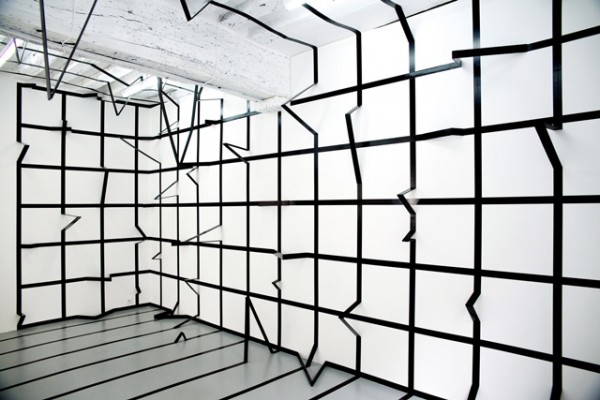Esther Stocker
Friday, 22 June 2012
Work from her oeuvre.
“In the late nineties Esther Stocker debuted with geometric abstract paintings, in which signs and orthogonal grids are superimposed on a limited range of colours: white, grey, black. In these paintings, the irregular grids recall the concept of ‘mimesis’ – not in the Platonic sense of the imitation of nature, but rather in the sense of ‘camouflage’ – and through that have the ability to test the perceptual faculties of the viewer. If these concepts evoke, in part, the experiences of Op Art, Stocker’s work stands apart from them because “her” camouflage is not hidden but revealed and showed through many irregular grids. They expand from the canvas into space and invade floors, ceilings, walls of galleries and museums, becoming sensory installations: the viewer interacts with them and his perception and feelings of alienation and disorientation became the leitmotif of Stocker’s pursuit and also protagonists in her two works of this exhibition. Indeed for the first installation, Stocker intervenes in the white space of the “tunnel” with black bars of various sizes on the floor, ceiling and walls: the viewer is surrounded by this grammar of components projecting into space and he is guided inside the room to the back wall, towards unknown and uncertain something. Via these few elements, the entire architectural appearance of the space is transformed, expanding beyond the physical limit of the walls. What interests the artist are not the black bars on the walls but the empty space between them, the disintegration of the environment: this fragmentation of the space produces spatial ambiguity and perceptual uncertainty that generates loneliness, despair, excitement.
In the second room, completely white, empty and silent, the title of the exhibition – ” La solitudine/dell’opera ” – manifests itself on two facing walls. Black threads are projected from every letter to different points into space, creating a kind of spider web: the installation lives and is completed only with the presence of the viewer who is invited to enter it. The influence of the Italian Group T of the ’60s is clearly visible – that of Gianni Colombo in particular, but also of the Hungarian psychologist Bela Julesz and the Italian painter and psychologist Gaetano Kanizsa. Also important to the work are its critical and literary references: indeed the title of the exhibition refers to an essay by Maurice Blanchot written in 1955, Lo spazio letterario. Stocker appropriates the French critic’s reflection on the “distance” – the solitude – between author and work that, rather than referring to an inability to communicate, opens the work up to readers and a multiplicity of meanings. The installation lives its own life, independently of the obsessions of its creator, who is condemned to an endless process of “sparking” other works which will become independent once completed. In this light the silence becomes the protagonist – a necessary condition to understanding this ‘loneliness’, which is also existential .
Stocker’s works provoke uncertainties in the viewer, putting their sense of control into constant doubt, via the perception “games” in her paintings and in the space installations . It is not too far an extension to see a parallel between the Blanchotian author, who is powerless to shape or dominate their work – as a consequence of which the act of “creation” is an illusion – and the man who thinks – equally illusorily – to have dominion over the world. The limit of man – Stocker teaches us – is his veil of certainty and control. As the artist herself asserts “Control is always what we do not have. This is the human condition. ” – Daniela Legotta




